Introduction
The Zeiss Distagon T* Otus 1,4/55 is the first of a new series of high-grade lenses from the maker optimized for the next generation of high-resolution DSLRs. This fast standard adopts the firm’s retrofocus Distagon type optical construction, a design previously only found on wide-angle models. It has a complex construction consisting of 12 elements in 10 groups, and features no less than six elements made from anomalous partial dispersion glass and one lens made with an aspherical surface. Although a manual focus design it has a ‘floating elements’ for close range correction and a minimum focus distance of 0.5m.
While the Canon mount (ZE) version lacks an aperture collar like that found on the Nikon (ZF.2) it has CPU contacts for data exchange and electronic aperture control. The result is a slightly longer (144mm vs 141mm) and heavier model (1030g vs 970g) than the Nikon mount version, although it measures the same 83mm at its widest point and retains the 77mm filter thread. The new 1,4/55 Otus is available for pre-order at $3,999 in Nikon and Canon mount only.
After the results of the Nikon mount version, it’s not really a surprise to see the 1,4/55 Otus outperform every Canon mount standard prime in our database. It achieves a very high DxOMark score of 38 points and a peak sharpness score of 21P-Mpix on the Canon EOS 5D Mk III.
Best standard prime on the Canon EOS 5D Mk III:
 |
 |
 |
 |
| Carl Zeiss Distagon T* Otus 1.4/55 ZE Canon | 3999 | 38 | 21 |
| Carl Zeiss Makro-Planar T 50mm f/2 ZE Canon | 1280 | 30 | 18 |
| Canon EF 50mm f/1.2L USM | 1574 | 29 | 16 |
| Sigma 50mm F1.4 EX DG HSM Canon | 499 | 29 | 15 |
| Canon EF 40mm f/2.8 STM | 249 | 29 | 18 |
| Canon EF 50mm f/1.8 II | 99 | 28 | 16 |
| Canon EF 50mm f/1.4 USM | 385 | 27 | 17 |
| Carl Zeiss Planar T 50mm f/1.4 ZE Canon | 725 | 25 | 16 |
Best prime on the Canon EOS 5D Mk III:
 |
 |
 |
 |
| Carl Zeiss Distagon T* Otus 1.4/55 ZE Canon | 3999 | 38 | 21 |
| Sigma 85mm F1.4 EX DG HSM Canon | 969 | 35 | 20 |
| Sigma 35mm F1.4 DG HSM A Canon | 899 | 34 | 19 |
| Canon EF 100mm f/2 USM | 440 | 33 | 16 |
| Canon EF 35mm f/2 IS USM | 850 | 33 | 20 |
| Carl Zeiss Makro-Planar T 100mm f/2 ZE Canon | 1840 | 32 | 20 |
| Canon EF 135mm f/2L USM | 1070 | 32 | 20 |
| Canon EF 300mm f/2.8L IS II USM | 6599 | 32 | 22 |
| Canon EF 85mm F1.2L USM | 1599 | 32 | 20 |
| Canon EF 85mm f/1.2L II USM | 1869 | 31 | 18 |
| Carl Zeiss Distagon T 35mm f/2 ZE Canon | 1030 | 31 | 17 |
| Canon EF 24mm f/1.4L II USM | 1550 | 31 | 19 |
| Carl Zeiss Distagon T 35mm f/1.4 ZE Canon | 1843 | 31 | 18 |
| Carl Zeiss Makro-Planar T 50mm f/2 ZE Canon | 1280 | 30 | 18 |
| Samyang 85mm f/1.4 Aspherique IF Canon | 285 | 30 | 15 |
| Canon EF 35mm f/1.4L USM | 1420 | 30 | 16 |
| Canon EF 400mm f/2.8L IS II USM | 10499 | 30 | 21 |
| Canon EF 50mm f/1.2L USM | 1574 | 29 | 16 |
| Sigma 50mm F1.4 EX DG HSM Canon | 499 | 29 | 15 |
| Samyang 35mm F1.4 AS UMC Canon | 599 | 29 | 14 |
When benchmarked against all the Canon mount primes we’ve analyzed on the Canon EOS 5D Mk III, the Zeiss Otus 1,4/55 convincingly occupies the top-slot sitting above highly regarded models such as the Sigma 85mm f1.4 EX DG HSM and the Art series 35mm f1.4 DG HSM A. In terms of peak sharpness it doesn’t quite topple the recently upgraded Canon EF 300mm f2.8L IS II USM (which achieved a 22P-Mpix score) but it matches the Canon EF 400mm f2.8L IS II USM at 21P-Mpix. However, the Otus 1,4/55 remains one of the sharpest lenses available for Canon users.
With a DxOMark lens rating of 38 points the Zeiss Otus 1,4/55 is highest performing lens we’ve measured on a Canon body. And, with a 21P-Mpix sharpness score it’s one of the sharpest lenses that we’ve analyzed. What really stands out is the full aperture performance.
Not only is it sharp but also it’s sharp from corner to corner and has less than 5% variation in acutance across the image field regardless of the aperture setting. Stopped down to f16 where diffraction has an effect on sharpness it has exceptionally high acutance (66%) and has less than 2% variation across the image field.
Fast standards like this usually suffer from heavy vignetting but that’s not the case here. Shading or vignetting is well controlled at full aperture and has all but disappeared by f2.8. Lateral chromatic aberration is also very low in a lens like this and distortion while measurable is barely noticeable in real world use.
Compared against Canon’s premium ultra-fast standard, the EF 50mm f1.2L, the Zeiss is a significantly better performer. Although the Zeiss has better uniformity throughout the aperture range the principal benefits are to be seen at the widest apertures. It has much higher sharpness and excellent homogeneity at full aperture with significantly lower levels of chromatic aberration and vignetting. For instance, on the Canon chromatic aberration is noticeable in the outer 50% of the image field.
When evaluated beside the firm’s existing fast standard Planar designs, the Distagon Otus 1,4/55 shows superior sharpness and uniformity. As for vignetting all three are very similar though when it comes to distortion the Planar 1,4/50 has noticeable barreling compared to the Otus and the Makro. And like the Canon EF 50mm f1.2L, the Planar 1,4/50 has similar levels of chromatic aberration extending from the central 50% of the frame to the edges and corners.
Without doubt Zeiss has achieved their goal of producing the finest fast standard prime available on the market today for full-frame DSLRs, but at a shade under $4000, image quality like that doesn’t come cheap.
There are a couple of other concessions to consider as well. The Zeiss lacks autofocus and being slightly larger and heavier than the firm’s Apo Sonnar T* 2,0/135 it’s not particularly discrete.
Despite that the Zeiss Otus T* 1,4/55 is a breathtaking example of what’s possible, and will likely go down in history as one of the classic fast standard designs of our time.


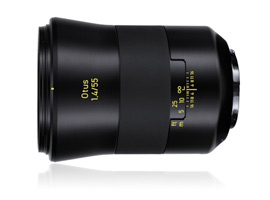



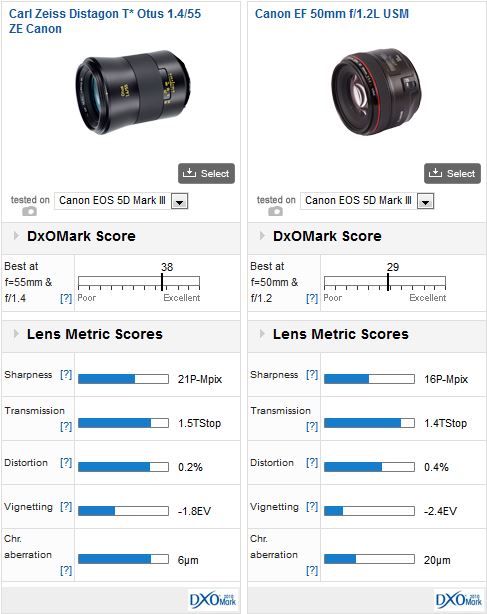
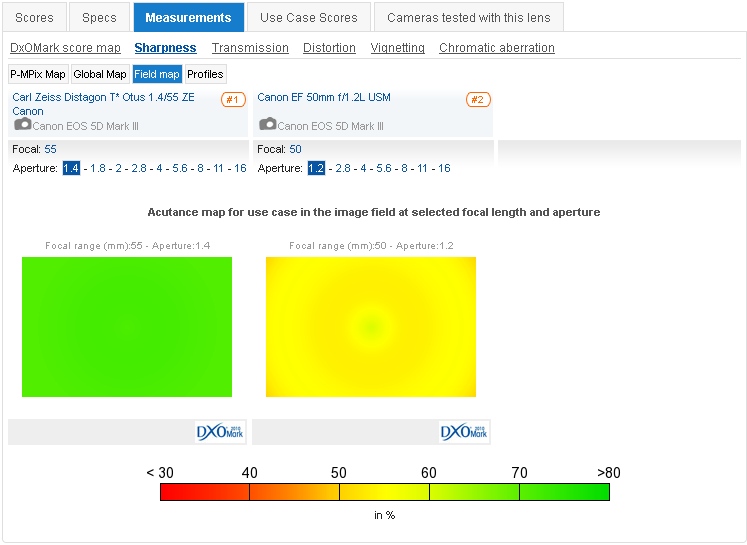
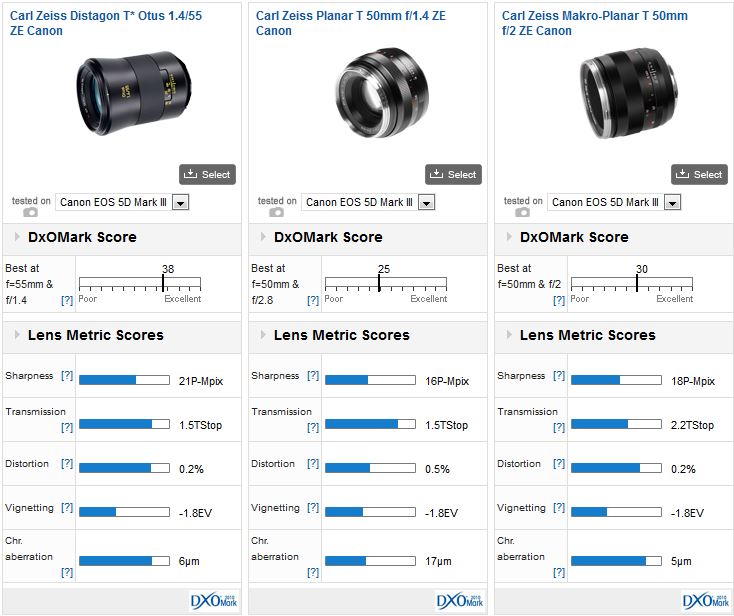
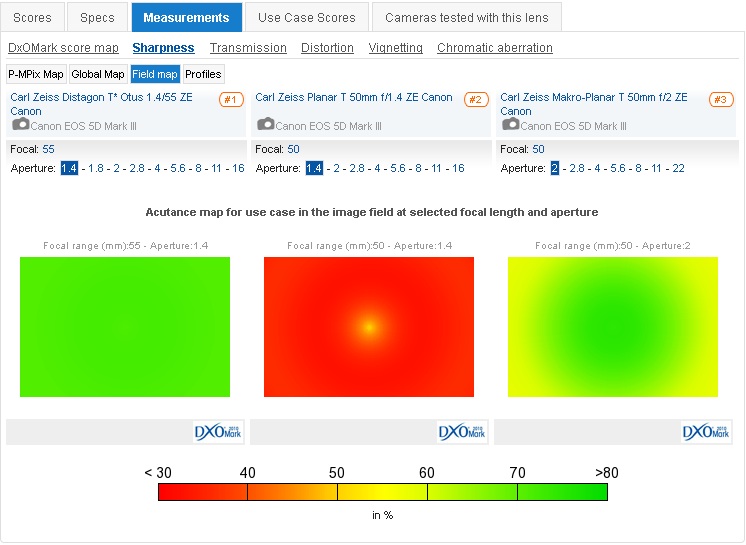
DXOMARK encourages its readers to share comments on the articles. To read or post comments, Disqus cookies are required. Change your Cookies Preferences and read more about our Comment Policy.